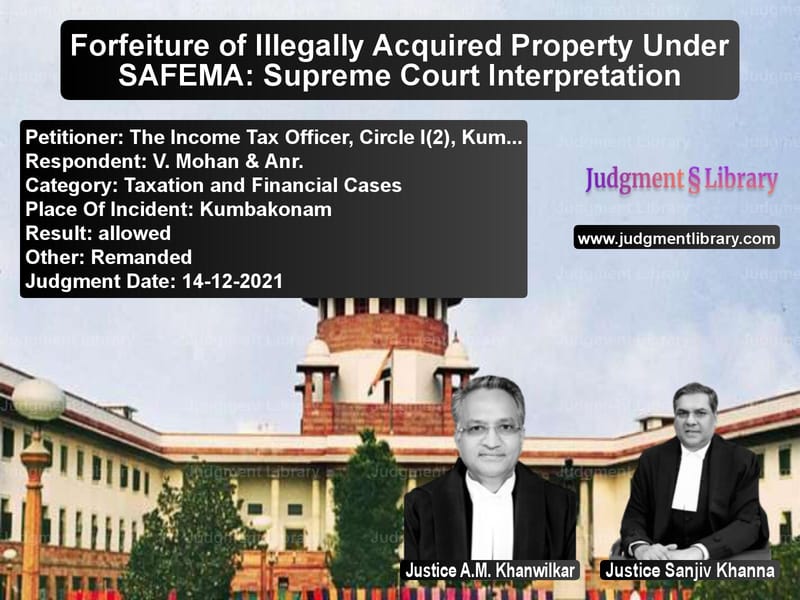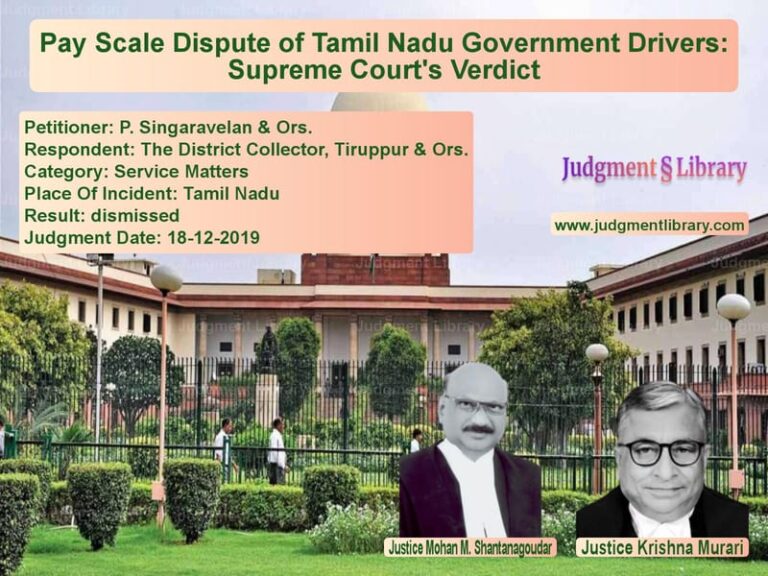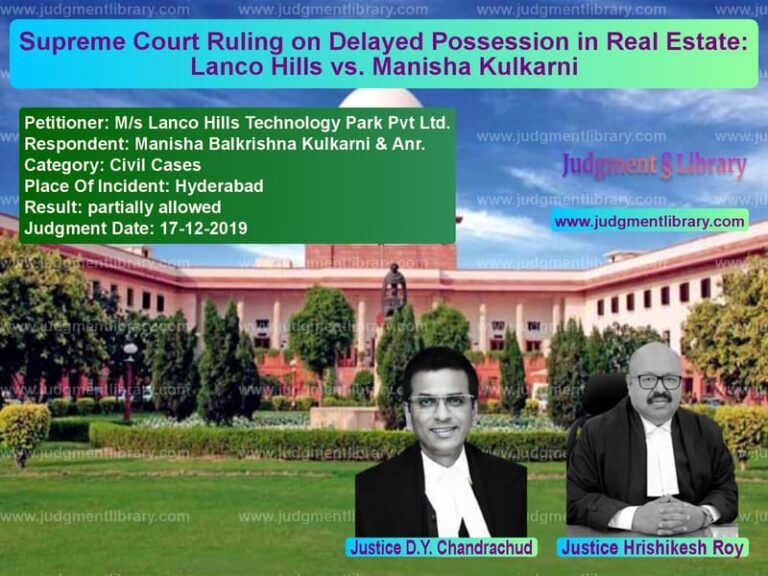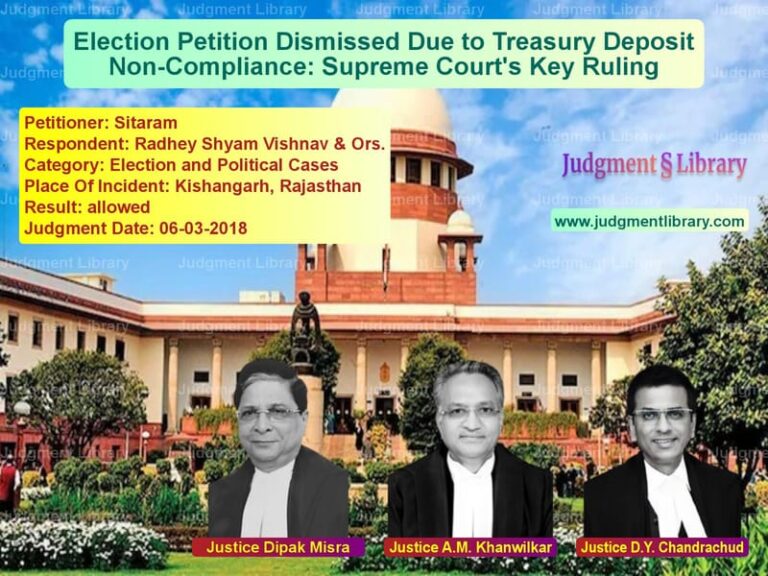Forfeiture of Illegally Acquired Property Under SAFEMA: Supreme Court Interpretation
The Supreme Court of India in its judgment on December 14, 2021, in the case of The Income Tax Officer, Circle I(2), Kumbakonam & Anr. v. V. Mohan & Anr., examined the scope and applicability of the Smugglers and Foreign Exchange Manipulators (Forfeiture of Property) Act, 1976 (SAFEMA). The primary issue before the Court was whether it was mandatory to serve a notice to the convict before initiating forfeiture proceedings against their relatives under Section 6 of SAFEMA.
The Court’s decision has significant implications in cases involving the forfeiture of properties allegedly acquired through unlawful means. The ruling clarified whether relatives of a convict or detenu could be held accountable for properties in their possession and whether failure to serve notice to the primary convict renders the proceedings against relatives invalid.
Background of the Case
SAFEMA was enacted to ensure that properties acquired through illegal activities by smugglers and foreign exchange manipulators do not remain in circulation. The Act applies to individuals convicted under certain offenses, their relatives, and associates holding assets believed to be illegally acquired.
The respondents, V. Mohan & Anr., were relatives of a person convicted under the Customs Act, 1962. The Competent Authority initiated forfeiture proceedings under SAFEMA, targeting properties held in their names. The respondents approached the High Court of Madras, which quashed the forfeiture proceedings, stating that the absence of a notice to the convict was a fatal flaw. The High Court ruled that without serving a notice to the convict, proceedings against relatives were invalid.
The Income Tax Department challenged this ruling before the Supreme Court, arguing that SAFEMA is designed to prevent convicts from shielding illegally acquired assets by transferring them to family members. The appeal sought clarity on whether the absence of a notice to the convict nullifies the forfeiture proceedings against relatives.
Arguments by the Petitioner (Income Tax Department)
The Income Tax Department, representing the Competent Authority, argued that:
- SAFEMA explicitly applies to individuals convicted of offenses and their relatives or associates who possess properties believed to be acquired through illegal means.
- There is no legal requirement under Section 6 to first serve a notice to the convict before proceeding against their relatives.
- The purpose of SAFEMA would be defeated if convicts could transfer assets to relatives to avoid forfeiture.
- Relatives holding assets are independently liable to prove that the properties were acquired through legal means.
- The High Court’s interpretation placed an unnecessary procedural burden that was not intended under the Act.
Arguments by the Respondents (V. Mohan & Anr.)
The respondents countered these claims by arguing:
- The forfeiture proceedings were invalid as no notice was served on the convict, as required under Section 6 of SAFEMA.
- Properties held by relatives cannot be forfeited unless it is first established that the convict’s assets were illegally acquired.
- The absence of a direct link between the convict’s unlawful activities and the respondents’ properties made the forfeiture illegal.
- The Competent Authority failed to prove that the respondents’ properties were acquired using illicit means.
Supreme Court’s Observations and Ruling
The Supreme Court, after reviewing the provisions of SAFEMA and previous judgments, made the following key observations:
- SAFEMA’s objective is to ensure that properties derived from illegal activities do not remain in circulation, even if transferred to relatives.
- The Act places the burden of proof on the noticee (i.e., the relative holding the property) to demonstrate that the assets were acquired through lawful means.
- The absence of a notice to the convict does not invalidate proceedings against relatives or associates.
- Section 6 of SAFEMA does not make it mandatory to first serve a notice to the convict before initiating action against their relatives.
- The High Court erred in holding that forfeiture proceedings were void solely due to the absence of a notice to the convict.
In delivering its ruling, the Supreme Court stated:
“The object of SAFEMA is to ensure that properties acquired through unlawful means do not remain in circulation. The requirement of issuing notice to the convict before initiating forfeiture proceedings against their relatives is not mandatory and cannot be used to frustrate the purpose of the Act.”
Key Legal Precedents Considered
- Attorney General for India v. Amratlal Prajivandas (1994) – Held that SAFEMA is applicable to properties held by both convicts and their relatives.
- Union of India v. Abdul Rashid (2001) – Clarified that forfeiture proceedings do not require a criminal conviction.
- State of Maharashtra v. Mohd. Yakub (1980) – Stressed that procedural lapses cannot be used to shield illegally acquired assets.
Implications of the Judgment
This judgment reinforces the principle that SAFEMA is designed to prevent convicts from bypassing the forfeiture process by transferring assets to relatives. The ruling establishes that:
- Authorities can initiate forfeiture proceedings directly against relatives without first serving notice to the convict.
- The burden of proof lies with the relative to establish that the properties in their possession were legally acquired.
- Courts must interpret SAFEMA to align with its legislative intent, ensuring that illegally acquired properties are confiscated effectively.
- Technical objections, such as procedural lapses, cannot be used to defeat forfeiture proceedings aimed at curbing economic offenses.
Final Verdict
The Supreme Court overturned the Madras High Court ruling and reinstated the forfeiture proceedings against the respondents. The matter was remanded to the High Court for further adjudication on any remaining legal and factual issues. This decision strengthens the enforcement of laws related to the forfeiture of assets linked to criminal activity and underscores the importance of ensuring that economic offenders do not retain benefits from illicit gains.
Petitioner Name: The Income Tax Officer, Circle I(2), Kumbakonam & Anr..Respondent Name: V. Mohan & Anr..Judgment By: Justice A.M. Khanwilkar, Justice Sanjiv Khanna.Place Of Incident: Kumbakonam.Judgment Date: 14-12-2021.
Don’t miss out on the full details! Download the complete judgment in PDF format below and gain valuable insights instantly!
Download Judgment: the-income-tax-offic-vs-v.-mohan-&-anr.-supreme-court-of-india-judgment-dated-14-12-2021.pdf
Directly Download Judgment: Directly download this Judgment
See all petitions in Income Tax Disputes
See all petitions in Tax Evasion Cases
See all petitions in Banking Regulations
See all petitions in Tax Refund Disputes
See all petitions in Customs and Excise
See all petitions in Judgment by A M Khanwilkar
See all petitions in Judgment by Sanjiv Khanna
See all petitions in allowed
See all petitions in Remanded
See all petitions in supreme court of India judgments December 2021
See all petitions in 2021 judgments
See all posts in Taxation and Financial Cases Category
See all allowed petitions in Taxation and Financial Cases Category
See all Dismissed petitions in Taxation and Financial Cases Category
See all partially allowed petitions in Taxation and Financial Cases Category







